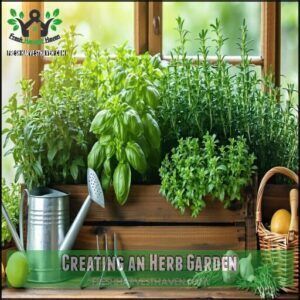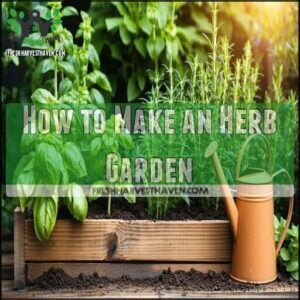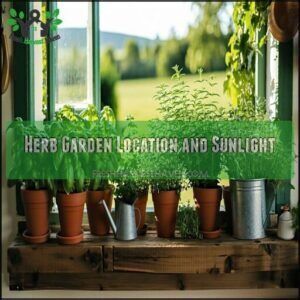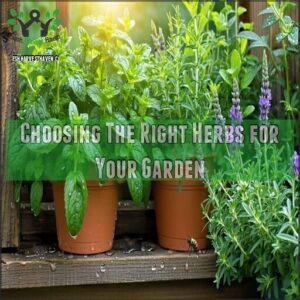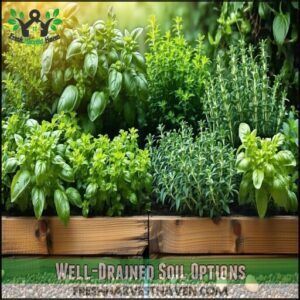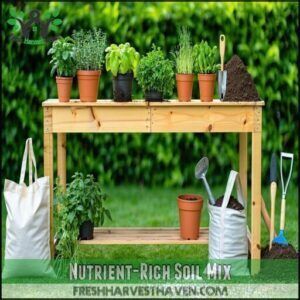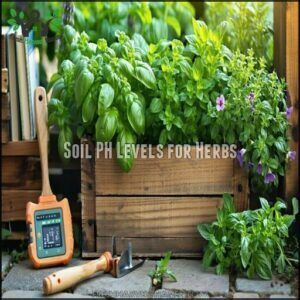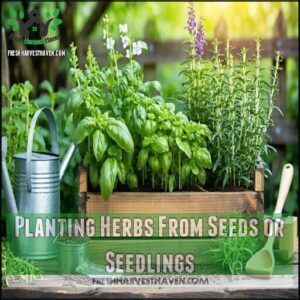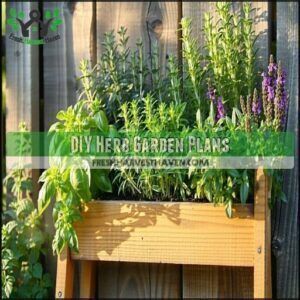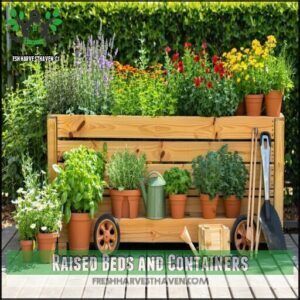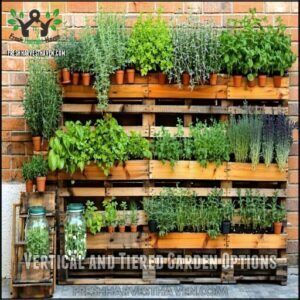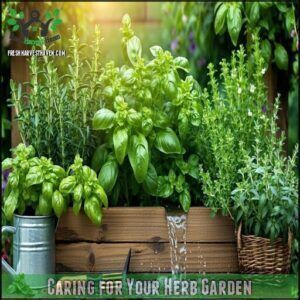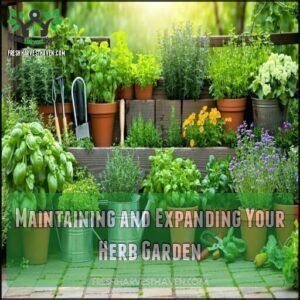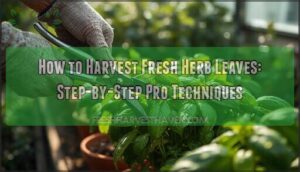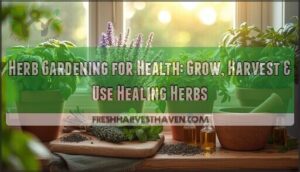This site is supported by our readers. We may earn a commission, at no cost to you, if you purchase through links.
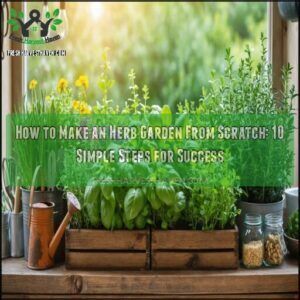
First, find a sunny spot close to your kitchen for easy access when cooking.
You’ll want to prepare the soil with a nutrient-rich mix and make certain of good drainage.
Choose a variety of your favorite herbs, considering both culinary and medicinal uses.
Plant seeds or seedlings, spacing them evenly.
Water regularly and fertilize with mulch for healthy growth.
Prune often to encourage bushiness.
Harvest frequently to promote growth and enjoy fresh herbs in your meals.
Keep reading for more in-depth tips on creating and maintaining your herb garden.
Table Of Contents
- Key Takeaways
- Creating an Herb Garden
- How to Make an Herb Garden
- Herb Garden Location and Sunlight
- Choosing The Right Herbs for Your Garden
- Preparing The Soil for Your Herb Garden
- Planting Herbs From Seeds or Seedlings
- Designing and Building Your Herb Garden
- Caring for Your Herb Garden
- Harvesting and Preserving Your Herbs
- Maintaining and Expanding Your Herb Garden
- Frequently Asked Questions (FAQs)
- How to start a vegetable and herb garden from scratch?
- How do I start a herb garden?
- Why should I start an herb garden?
- How do I choose a place to grow a herb garden?
- Should you build a herb garden?
- How do you make a raised herb garden planter?
- How do you start an herb garden for beginners?
- Which herbs should not be planted together?
- What month should you start an herb garden?
- What is the best layout for an herb garden?
- Conclusion
Key Takeaways
- Find a sunny spot for your herb garden, aiming for 6+ hours of daily direct sunlight.
- Prepare well-drained soil with a slightly acidic to neutral pH level, and make sure it is nutrient-rich.
- Choose herbs based on your culinary and medicinal needs, including perennials, annuals, and biennials.
- Water regularly, prune often, and harvest a third of the plant’s volume to promote growth and maintain a healthy herb garden.
Creating an Herb Garden
Creating an herb garden is a fun and rewarding project.
Creating an herb garden is a fun and rewarding DIY project.
You’ll learn how to select the perfect spot, prepare the soil, and choose herbs that will thrive and enhance your culinary creations.
Assessing The Location
Finding the perfect spot for your herb garden is key. Most herbs crave sunlight, so aim for 6+ daily hours of direct sunlight.
If you’re gardening indoors, a bright windowsill works great. Easy access to water is essential, and proximity to your kitchen makes cooking with fresh herbs convenient.
Keep mint in check—it tends to take over! Consider garden layout, drainage, and wind protection.
It’s all about creating the right environment for your herbs to thrive. To guarantee a thriving garden, understanding spring gardening techniques is also vital.
Preparing The Soil
Now that you’ve scouted the perfect spot, it’s time to get your hands dirty and prepare that soil.
Start by testing its pH; most herbs thrive in slightly acidic to neutral soil, aiming for a sweet spot between 6.0 and 7.0.
To enhance drainage, especially if you’re dealing with dense soil, mix in perlite.
This will create a healthier environment for your herbs’ roots.
Boost nutrient content and improve drainage further by adding organic compost and coarse sand or perlite.
If you’re working with heavy clay, consider raised beds or containers filled with a premium potting mix to make your gardening journey smoother.
Choosing The Right Herbs
Choosing herbs for your garden is all about what you’ll use in the kitchen.
Start with the best herbs for beginners, like chives and parsley—they add flavor and nutrients to your dishes.
Here are three beginner-friendly powerhouses to get you going:
- Basil: Perfect for adding that Italian flair to your dishes or whipping up a fresh pesto.
- Thyme: A hardy, versatile herb that’s great for soups and roasts.
- Mint: Easy to grow and perfect for teas and cocktails; just be careful, as it can take over your garden!
Remember, it’s better to have a few herbs you use and love than a jungle of untouched plants.
How to Make an Herb Garden
Building an herb garden is like creating your own flavor lab at home.
Before you start, consider these three key ingredients:
- Sunlight: Aim for a south-facing spot that gets at least 6 hours of direct sunlight daily—the perfect recipe for healthy herbs.
- Container or Raised Bed: Make certain your container or raised bed has excellent drainage. Waterlogged herbs are unhappy herbs.
- Soil: Use high-quality potting soil mixed with organic compost for the best results.
By adopting zero waste garden practices, you can minimize your environmental footprint while growing your herbs.
Now, let’s get growing! Start small and expand as your green thumb confidence grows.
Herb Garden Location and Sunlight
Finding the perfect spot for your herb garden is key.
You’ll want to choose a sunny location, but also consider partial shade options.
You should also consider how close it’s to your kitchen for easy access to your tasty, fresh herbs.
Selecting a Sunny Spot
Sunlight is like food for your herbs, and they need a lot of it. Aim for at least 6 hours of direct sunlight daily—think of a beach-loving teen soaking up the rays.
Scout your yard for the perfect spot, focusing on south-facing areas that catch the morning to mid-afternoon sun. Keep in mind that raised beds can improve drainage and soil quality.
Don’t underestimate the power of a gentle breeze—it strengthens stems. But be cautious of strong winds, which can damage delicate plants. Your herbs will thank you for finding that sweet spot between sunshine and protection.
Understanding herb garden basics is essential for creating an ideal environment for your herbs to thrive.
Partial Shade Options
Don’t fret if your garden receives dappled shade throughout the day. Herbs like mint and lemon verbena thrive in these conditions, and some even prefer a break from the intense rays during the hottest parts of the day.
When designing your herb garden, consider including these shade-tolerant herbs that bring a unique flavor to your meals.
- Mint varieties will spread vigorously in cool, shaded spots.
- Parsley and chervil produce tender leaves with a subtle flavor boost when grown in filtered light.
- Cilantro and dill last longer and remain productive without full sun exposure.
- Lemon balm and oregano adapt well to moderate shade, offering an invigorating twist to your dishes.
Proximity to The Kitchen
Having your herb garden near the kitchen is a no-brainer.
You’ll love the convenience of stepping out to grab some basil or mint for your recipes or a cup of tea.
Finding the right spot within 20 steps of your kitchen door encourages daily use and makes herb gardening truly enjoyable.
Just make certain your garden layout balances this cooking convenience with the herbs’ sunlight needs.
Choosing The Right Herbs for Your Garden
Choosing the right herbs for your garden is key to its success.
Go for a mix of perennial, annual, and biennial herbs, selecting varieties that align with your culinary and medicinal needs.
Perennial, Annual, and Biennial Herbs
Now that you’ve scouted a sunny spot, it’s time to talk about the different types of herbs you can grow.
Understanding herb life cycles is key to designing a garden that keeps on giving year after year.
Here’s a breakdown:
- Perennials like thyme and oregano are loyal companions that return each spring.
- Annuals, such as basil, require replanting annually but offer intense flavor.
- Biennials, including parsley, give you two years of growth.
- Some herbs self-seed, providing free plants for your garden.
- Tender perennials might need a cozy blanket (winter protection) to survive colder months.
Herbs for Culinary Use
Now that you know about the different types of herbs and their lifecycles, let’s spice things up and talk about choosing the right herbs for your culinary creations.
It’s time to match your herb selections with the flavors you love to cook. Here’s a quick guide to help you pair herbs with your favorite dishes and cuisines.
Imagine whipping up an Italian feast—basil and oregano are your go-to herbs for that perfect pasta or pizza sauce. For French cuisine, tarragon and thyme are ideal for adding depth to sauces and soups.
If you’re an Asian food enthusiast, cilantro and Thai basil will be your dynamic duo for stir-fries and curries. Grilling Mediterranean-style? Rosemary and sage are the heroes for flavoring meats and vegetables.
Understanding common herbs is essential to creating delicious meals.
Herbs for Medicinal Use
Growing medicinal herbs connects you to nature’s ancient pharmacy. It’s empowering to cultivate a healing garden, and these three time-tested herbs are a great start.
- Echinacea: This immune-boosting warrior fights off colds and infections, keeping you strong and healthy.
- Chamomile: Nature’s calm in a cup, it soothes nerves and promotes restful sleep, a natural remedy for anxious minds.
- Peppermint: Say goodbye to tummy troubles and headaches with this invigorating herb, a natural digestive aid, and a great way to boost your overall well-being with medicinal herbs.
Preparing The Soil for Your Herb Garden
Creating the perfect environment for your herbs starts with the soil.
You’ll learn how to prepare a well-drained, nutrient-rich blend with the right pH level, ensuring your herbs get the best possible start.
Well-Drained Soil Options
Well-drained soil is key to a thriving herb garden, and there are a few simple ways to achieve this.
Try mixing gravel and sand into your existing soil for better drainage, or opt for raised beds with pre-drilled holes. If you’re using containers, line the bottom with pebbles before adding soil.
For stubborn areas, consider sloping your garden bed or installing underground drainage pipes. These methods guarantee your herbs’ roots stay happy and healthy, preventing waterlogging and potential rot.
Proper drainage systems, including effective drainage pipe systems, are vital for maintaining ideal soil conditions.
Nutrient-Rich Soil Mix
Give your herbs a nutritious meal with a balanced soil mix.
Start with good garden soil, then boost it with equal parts high-quality compost, aged manure, and perlite or coarse sand.
This powerhouse blend provides slow-release nutrients, beneficial microbes, and improved drainage, giving your herbs a healthy, happy home without breaking the bank.
By using a mix with the right soil mix ratios, you can create an ideal environment for your herbs to thrive, with the perfect combination of nutrients and drainage.
Soil PH Levels for Herbs
Soil pH is like a comfort zone for your herbs—they’ll thrive when it’s just right.
Each herb variety has its sweet spot regarding pH levels. Basil and mint prefer a slightly acidic environment with a pH between 6.0 and 7.0. Thyme and sage, on the other hand, are happy campers in neutral territory, with a pH ranging from 6.5 to 7.5.
To keep your herbs healthy and identify any issues, test your soil’s pH with a simple kit from your local garden store. It’s like giving your plants a wellness check-up!
Planting Herbs From Seeds or Seedlings
Planting herbs from seeds or seedlings is a simple process, and with the right care, you’ll soon see your garden flourish.
This section will guide you through the steps of sowing seeds, transplanting seedlings, and ensuring proper spacing and depth for your herb garden.
Sowing Seeds Indoors and Outdoors
Starting herb seeds indoors gives you a head start and more control over the growing process.
It’s a great option for slower-germinating herbs like oregano. Use seed trays with moistened potting mix and sprinkle seeds on top—basil, dill, and cilantro are perfect for beginners.
For outdoor sowing, wait for soil temperatures to reach the 60s (°F). Mark your calendar for six weeks before the last frost date to begin.
Proper use of herb seed trays is essential for successful indoor seed starting.
Setting Out Transplants
It’s time to introduce your indoor seedlings to the great outdoors.
The ideal time for transplanting herbs is during mild temperatures, so opt for early mornings or late afternoons.
Carefully remove each seedling, keeping the root ball intact, and place them in pre-moistened soil, ensuring the crown sits at the same level as before.
Water generously and add mulch to lock in that moisture, which will help your herbs thrive in their new environment.
Your herbs will thank you for this smooth relocation to their new home!
Spacing and Depth Guidelines
In regard to your herb garden, spacing is key. Give your herbs some personal space—12–18 inches for bushier varieties like sage and rosemary, and 6–8 inches for compact herbs such as thyme and oregano. This makes certain they’ve room to grow and breathe.
When planting, follow these three simple steps:
- Dig holes twice as wide as the root ball.
- Keep the depth the same as the original container.
- In containers, maintain good airflow between plants.
By following these guidelines, you can ensure your herbs have the room to grow and thrive in their environment.
Designing and Building Your Herb Garden
Now that you’ve chosen the perfect spot for your herb garden and selected the right herbs, it’s time to get started on the fun part: designing and building it.
From DIY plans to raised beds, containers, and vertical options, you have plenty of choices to create a functional and beautiful herb garden, with complete concepts in mind.
DIY Herb Garden Plans
Your vision of a vibrant herb garden is about to take off with these creative DIY plans.
Designing your herb garden layout is an exciting step toward enjoying fresh herbs.
Here are four proven designs to transform everyday items into a stunning garden:
- Give new life to an old wooden ladder, displaying your herbs vertically.
- Recycle gutters into a living wall, creating a unique herb garden.
- Build a classic A-frame herb stand with cedar, a simple yet effective design.
- Stagger shelving on a rustic pallet garden for an eclectic, space-saving option.
These ideas offer an excellent starting point for your herb garden plans to create a stunning garden with fresh herbs.
Raised Beds and Containers
Take control of your herb garden by embracing the flexibility of container and raised bed gardening. This approach offers the ultimate in control over your garden’s growing conditions.
For a simple, long-lasting solution, build a raised bed using cedar boards, which are naturally rot-resistant. Alternatively, choose terra cotta pots with drainage holes or repurpose wooden boxes for container gardening.
Fill your containers with a well-draining potting mix, and you’re ready to plant. A bonus tip for larger containers is to add wheels for easy mobility.
This way, you can easily move your herb garden around to capture the sun or simply change up your outdoor space. When designing your garden, consider using cedar raised beds for their durability and resistance to rot.
Vertical and Tiered Garden Options
Space constraints don’t hinder your green thumb aspirations. Vertical and tiered gardens are your gateway to a lush herb garden.
- Wall of Green: Mount a wooden pallet on your wall, creating an instant vertical garden.
- Staircase to Herbs: Build a three-tiered cedar stand, showcasing your herbs on each step.
- Sunlight Spectrum: Each level captures sunlight differently, offering diverse microclimates for various herbs.
- Garden Up: Stack your herbs upward with vertical planters, perfect for small spaces like patios or balconies.
- Herb Walls: Create a living wall of flavors with hanging planters or mason jars, a space-saving solution for your kitchen.
Caring for Your Herb Garden
Now that your herb garden is thriving, it’s important to know how to care for it properly.
Creating an herb garden is a rewarding project—a flavor lab at home.
We’ll cover the essentials like watering, pruning, and dealing with pests to keep your herbs happy and healthy.
Watering and Fertilizing
Watering and fertilizing your herb garden is key to its success. You want to keep the soil moist, but not soggy, as too much water can be as harmful as too little. Aim for a consistent watering schedule.
Herbs thrive with water conservation methods, and well-prepared soil keeps plants healthy. Choose organic fertilizers like compost for a natural nutrient boost. Understanding proper watering techniques is vital for a thriving garden.
Here’s a simple guide to watering and fertilizing your herb garden:
Pruning and Harvesting
To keep your herb garden flourishing, pruning and harvesting are key.
Here are some tips:
- Time it right: Harvest in the morning to capture the best flavor.
- Know your technique: Grab some sharp scissors and cut above the growth points.
- Don’t overdo it: Take no more than a third of the plant’s volume.
- Preserve: Dry or freeze your harvest to enjoy year-round.
Your herbs will thank you for it, and with these tips, you can enjoy a flourishing herb garden.
Pest and Disease Management
Pests and diseases can wreak havoc on your herb garden if you’re not careful.
It’s important to be proactive and implement some simple pest control and disease prevention strategies.
Start with organic methods like introducing beneficial bugs—ladybugs are great for munching on aphids.
Keep weeds under control and use natural fungicides for common herb ailments.
Vigilant care and regular inspections will keep your herbs healthy and happy.
Harvesting and Preserving Your Herbs
Harvesting and preserving your herbs is a rewarding step, offering fresh flavors year-round.
You’ll learn how to pick the right time to harvest, dry, or freeze your herbs, and store them for future use.
Leafy Herbs and Flower Harvesting
Harvesting your leafy greens and flowers is an art, and timing is everything.
Here’s a mini-guide to help you master the cut:
- Go for it in the morning—that’s when the oils are at their most flavorful.
- Take no more than a third of the plant at a time for maximum yields.
- A clean cut keeps pests away and your herbs healthy.
- Treat your herbs like flowers and store whole stems in water.
Drying and Freezing Herbs
There are several ways to lock in the flavor of your herbs and extend their shelf life.
Drying herbs is simple: hang them in a cool, airy spot until they’re dry. Freezing is even easier—just chop, then pack into containers or bags.
These methods guarantee your homegrown herbs are always within reach.
Explore different drying methods like air-drying, oven-drying, or vine-drying. Air-drying works great for sturdier herbs like rosemary, while oven-drying suits mint, sage, and bay leaf.
Freezing herbs in oil or as-is also preserves their flavor and color for up to a year. Microwaving is another option, but it only offers moderate flavor retention.
Discover which techniques work best for your herb garden’s bounty!
Herb Storage and Usage
Now that your herbs are dried and frozen, it’s time to talk about keeping those flavors fresh.
Store your herbs in airtight containers to lock in their aroma and taste.
Then, get creative and experiment with these three fun ideas:
- Cooking Adventures: Spice up your favorite dishes with dried herbs.
- Herb Teas: Brew soothing teas with your very own aromatic blends.
- Crafty Creations: Get crafty and create herb-infused gifts for your loved ones.
Maintaining and Expanding Your Herb Garden
Now that your herb garden is flourishing, learn how to maintain its success through seasonal care, companion planting, and expansion.
We’ll also explore ways to renovate your garden if you’re feeling adventurous and want to take your herb-growing skills to the next level.
Seasonal Herb Garden Maintenance
Keep your herb garden in tip-top shape with seasonal maintenance. A healthy herb garden needs year-round care. A green thumb’s work is never done, but it’s worth it!
Come spring, roll up your sleeves for a vigorous garden cleanup.
As summer heats up, focus on pest control to protect your delicate herbs.
When fall arrives, it’s pruning time to get your herbs ready for their winter nap.
And don’t forget to boost your soil’s health with amendments during these seasonal shifts. Check out the table below for a quick overview of seasonal tasks.
Companion Planting and Crop Rotation
Basil and tomatoes make the perfect pair, each boosting the other’s growth. By embracing companion planting, you’re not just creating a vibrant herb garden, but also a pest-free one.
Annual crop rotation is another trick to keep your garden thriving. It’s like giving your soil a break, dodging pests and diseases, and keeping soil health in check.
These simple strategies guarantee your garden from scratch stays healthy and productive, offering a yield boost and a natural form of pest control.
Herb Garden Expansion and Renovation
If you’re itching to expand your herb garden, think big! Here are five ways to get started:
- Add raised beds for more space and better soil control.
- Introduce vertical planters to maximize growing areas.
- Repurpose old materials to save costs and get creative.
- Plan carefully; a well-thought-out expansion will pay dividends.
- Don’t forget to winterize your garden to protect your herbs during colder months.
With these tips, you’ll be well on your way to a thriving, expanded herb garden!
Frequently Asked Questions (FAQs)
How to start a vegetable and herb garden from scratch?
You’ve decided to become earth’s caretaker? Smart move!
Clear a sunny spot, prepare soil with compost, plant seedlings at proper spacing, and water regularly.
Don’t forget to label everything you’ve planted!
How do I start a herb garden?
Choose a sunny spot, grab some pots or dig a small bed, and fill with well-draining soil.
Plant your favorite herbs like basil or mint, water regularly, and harvest often for best results.
Why should I start an herb garden?
You’ll reap what you sow with an herb garden.
You’ll save money, enjoy fresher flavors, boost your mood through gardening, and have herbs handy whenever you need them for cooking or tea.
How do I choose a place to grow a herb garden?
You’ll need a spot with 6-8 hours of sunlight daily.
South-facing locations work best.
Place it near your kitchen for easy access and consider wind exposure—gentle breezes help herbs thrive.
Should you build a herb garden?
Like breathing life into your kitchen, yes! You’ll save money on store-bought herbs, enjoy superior flavors in cooking, and find gardening surprisingly therapeutic.
It’s an easy, rewarding project that keeps on giving.
How do you make a raised herb garden planter?
Build a raised herb garden by constructing a wooden frame with cedar boards.
Filling it with quality soil, and ensuring proper drainage, are crucial steps to create a thriving herb garden.
You’ll enjoy fresh herbs right outside your door all season long.
How do you start an herb garden for beginners?
You’ll be amazed how easy growing herbs can be!
Start with 2-3 herbs like basil and mint in small pots, place in a sunny spot.
Water when soil feels dry, and harvest regularly.
Which herbs should not be planted together?
Keep mint isolated as it’ll take over.
Don’t plant dill near fennel or coriander. Basil dislikes rue.
Separate sage from cucumber plants.
Tarragon and rosemary shouldn’t share space with moisture-loving herbs.
What month should you start an herb garden?
Start your herb garden in spring, after the last frost.
You’ll have better success with warmer soil temperatures and longer days.
Fall planting works in milder climates where winter isn’t harsh.
What is the best layout for an herb garden?
The ideal herb garden layout groups plants with similar needs together.
You’ll want circular or tiered designs for accessibility, keeping tall herbs in back and frequently used ones closest to your kitchen.
Conclusion
Planting and pampering your own herb garden from scratch gives you endless culinary possibilities.
You’ve now got the knowledge to select sites, prepare soil, and pick perfect plants for your needs.
Don’t forget—herbs are hardy, so don’t worry if you make mistakes.
They’ll forgive you! With regular watering, pruning, and harvesting, you’ll enjoy fresh flavors year-round.
Ready to get your hands dirty? Learning how to make an herb garden from scratch isn’t just useful—it’s deeply satisfying.
- https://www.gardenary.com/blog/how-to-start-an-herb-garden
- https://beautifuleatsandthings.com/2020/04/22/how-to-start-an-outdoor-herb-garden-for-beginners/
- https://www.gardenersworld.com/how-to/grow-plants/how-to-create-a-herb-garden/
- https://bonnieplants.com/blogs/garden-fundamentals/how-to-grow-an-herb-garden/
- https://www.bbcgoodfood.com/howto/guide/how-make-herb-garden

